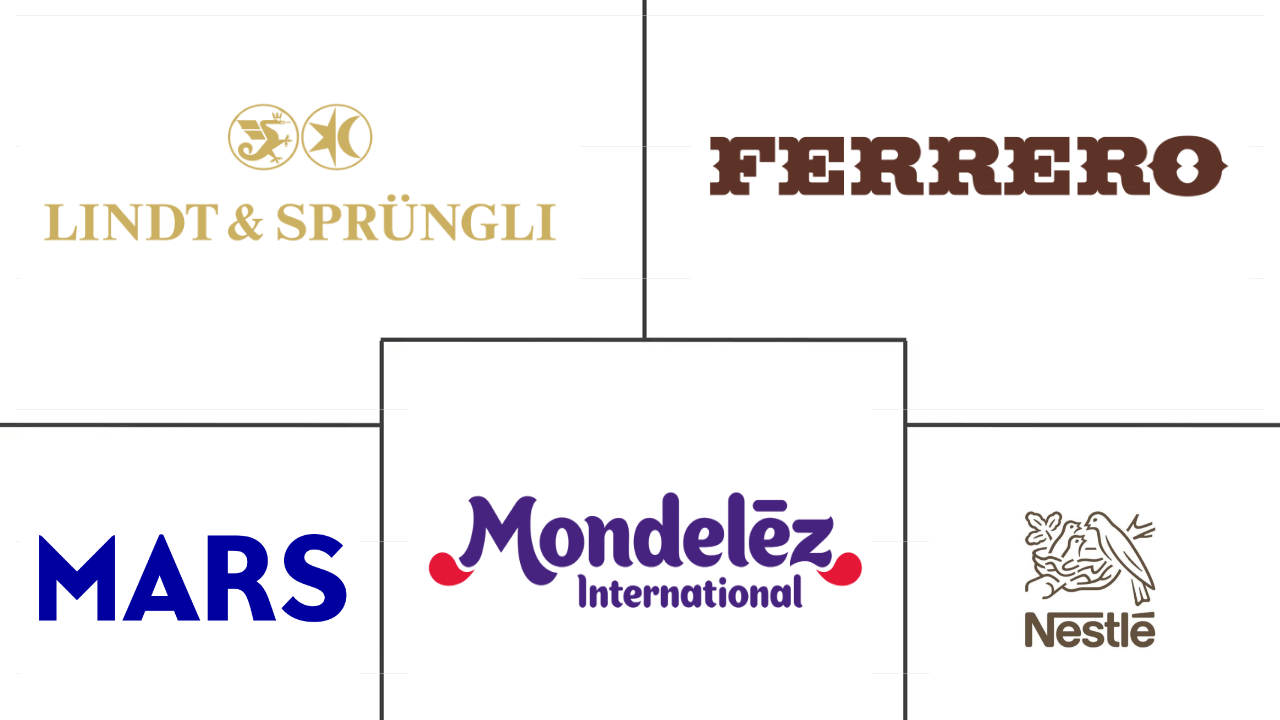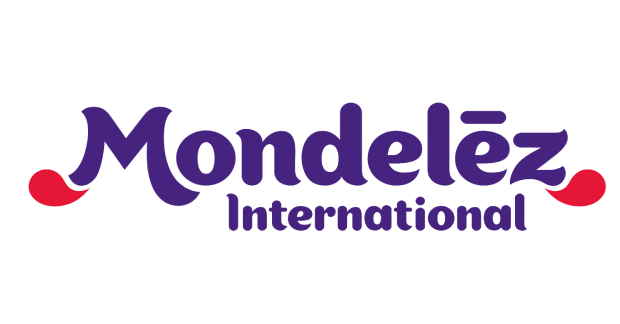Market Size of europe confectionery Industry
|
|
Study Period | 2018 - 2030 |
|
|
Market Size (2024) | USD 69.40 Billion |
|
|
Market Size (2030) | USD 90.90 Billion |
|
|
Largest Share by Distribution Channel | Supermarket/Hypermarket |
|
|
CAGR (2024 - 2030) | 4.60 % |
|
|
Largest Share by Country | United Kingdom |
Major Players |
||

|
||
|
*Disclaimer: Major Players sorted in no particular order |
Europe Confectionery Market Analysis
The Europe Confectionery Market size is estimated at 69.40 billion USD in 2024, and is expected to reach 90.90 billion USD by 2030, growing at a CAGR of 4.60% during the forecast period (2024-2030).
69.40 Billion
Market Size in 2024 (USD)
90.90 Billion
Market Size in 2030 (USD)
3.05 %
CAGR (2018-2023)
4.60 %
CAGR (2024-2030)
Largest Segment by Confections
68.14 %
value share, Chocolate, 2023
Increasing chocolate manufacturing facilities in countries like the Netherlands, Germany, Italy, and Belgium made chocolate a larger segment in the region in the study period.
Largest Segment by Distribution Channel
41.67 %
value share, Supermarket/Hypermarket, 2023
Supermarkets and hypermarkets are the key off-trade distribution channels in the region, as consumers prefer purchasing chocolates, other confectioneries, items together.
Fastest-growing Segment by Confections
7.57 %
Projected CAGR, Snack Bar, 2024-2030
Consumers are replacing conventional snacks with snack bars, growing and witnessing an ever-expanding array of flavors and healthy varieties to supplement eating habits.
Fastest-growing Segment by Distribution Channel
6.46 %
Projected CAGR, Online Retail Store, 2024-2030
The ability to use online marketing tools to target new customers and website analysis tools to gain insight into regional product-specific consumers is driving the segment.
Leading Market Player
16.37 %
market share, Mondelēz International Inc., 2022

The active market activities, like product innovations and strategic moves by Mondelēz, along with the unique portfolio, are enabling the company to grow ales in the market.
Supermarkets and convenience stores collectively account for more than 75% of the market share as nationwide store chains allow broader reach and easy access to multiple brands
- Supermarkets/hypermarkets have always maintained a strong lead in the sales of confectionery in the region. Chocolate is largely sold confection through supermarkets and hypermarkets, with a market volume share of 50.89% in 2022. Strategic product positioning on the dedicated shelves for the confectionery category influences impulse purchase behavior among potential consumers. Casino Supermarkets, Carrefour, Super U, and Lidl are some of the leading grocery store operators in the region. A nationwide network of these operators allows easy access to local and mainstream confectionery brands. As of 2023, Lidl operated more than 3,000 and 1,500 stores in Germany and France, respectively. Carrefour operates around 2,869 supermarkets across the region.
- Convenience stores are the second most widely preferred distribution channel after supermarkets and hypermarkets for purchasing confectionery. The volume sales of confectionery through convenience stores is estimated to register a 38.96% volume share in 2024. The broader reach and easy access to private label brands drive the consumer preference for traditional grocery stores over other retail channels. Snack bar sales are estimated to grow at the highest CAGR through convenience stores, reaching a sales value of USD 1,761.98 million in 2030.
- The online channel is projected to be the fastest-growing distribution channel for confectionery, with an anticipated CAGR of 6.13% in terms of value during the forecast period. The increasing number of internet users influences the evolving role of online channels in grocery purchases. In 2022, 68% of European consumers aged 16 to 74 bought online goods or services for personal use.
High consumption of chocolates and candy across Germany, the United Kingdom, and France contributes to the growth of the confectionery market in Europe
- The United Kingdom and Germany are identified as the major markets in the region, followed by France and Russia. Germany and the United Kingdom collectively accounted for a 39.21% share of the overall confectionery sales volume across the region in 2023. Consumer preference for tasty and convenient indulgent snacking is identified as the key market driver in the region. In 2022, 72% of German snackers consumed candy and chocolate bars every week. In Germany, chocolate sales are anticipated to register the highest CAGR of 4.98% during the forecast period to reach a sales value of USD 13,937.01 million in 2030.
- In France, the confectionery market is characterized by the large cocoa-processing and chocolate-manufacturing industry. Chocolate had a 68.68% share of the overall confectionery consumption in 2022. Consumer shift toward easy-to-prepare food is estimated to foster the demand for snack bars during the forecast period. In 2022, 44% of French consumers preferred quick food as part of at-home breakfasts.
- Turkey and Spain are identified as the fastest-growing confectionery markets in Europe. The Turkish market is anticipated to expand at a CAGR of 5.69% during 2023-2030 in terms of value. The traditional popularity of sugar confectionery as gifts during religious festivals, wedding ceremonies, and celebrations fuels the market’s growth in Turkey.
- In Spain, chocolate and sugar confectionery are top-selling confections and collectively had a volume share of 93.674% in 2023. A healthy snacking trend is anticipated to promote the consumption of dark chocolates and sugar-free confectionery in Spain. In 2021, 55.4% of consumers preferred to spend more on healthier food options. Dark chocolate sales volume is anticipated to register a CAGR of 5.98% during the forecast period.
Europe Confectionery Industry Segmentation
Chocolate, Gums, Snack Bar, Sugar Confectionery are covered as segments by Confections. Convenience Store, Online Retail Store, Supermarket/Hypermarket, Others are covered as segments by Distribution Channel. Belgium, France, Germany, Italy, Netherlands, Russia, Spain, Switzerland, Turkey, United Kingdom are covered as segments by Country.
- Supermarkets/hypermarkets have always maintained a strong lead in the sales of confectionery in the region. Chocolate is largely sold confection through supermarkets and hypermarkets, with a market volume share of 50.89% in 2022. Strategic product positioning on the dedicated shelves for the confectionery category influences impulse purchase behavior among potential consumers. Casino Supermarkets, Carrefour, Super U, and Lidl are some of the leading grocery store operators in the region. A nationwide network of these operators allows easy access to local and mainstream confectionery brands. As of 2023, Lidl operated more than 3,000 and 1,500 stores in Germany and France, respectively. Carrefour operates around 2,869 supermarkets across the region.
- Convenience stores are the second most widely preferred distribution channel after supermarkets and hypermarkets for purchasing confectionery. The volume sales of confectionery through convenience stores is estimated to register a 38.96% volume share in 2024. The broader reach and easy access to private label brands drive the consumer preference for traditional grocery stores over other retail channels. Snack bar sales are estimated to grow at the highest CAGR through convenience stores, reaching a sales value of USD 1,761.98 million in 2030.
- The online channel is projected to be the fastest-growing distribution channel for confectionery, with an anticipated CAGR of 6.13% in terms of value during the forecast period. The increasing number of internet users influences the evolving role of online channels in grocery purchases. In 2022, 68% of European consumers aged 16 to 74 bought online goods or services for personal use.
| Confections | |||||||||||
| |||||||||||
| |||||||||||
| |||||||||||
|
| Distribution Channel | |
| Convenience Store | |
| Online Retail Store | |
| Supermarket/Hypermarket | |
| Others |
| Country | |
| Belgium | |
| France | |
| Germany | |
| Italy | |
| Netherlands | |
| Russia | |
| Spain | |
| Switzerland | |
| Turkey | |
| United Kingdom | |
| Rest of Europe |
Europe Confectionery Market Size Summary
The Europe Confectionery Market is experiencing steady growth, driven by a strong preference for chocolate and snack bars, with supermarkets and hypermarkets leading in sales distribution. The strategic placement of confectionery products in these stores encourages impulse purchases, while convenience stores also play a significant role in the market. The online channel is emerging as the fastest-growing distribution method, reflecting the increasing number of internet users and their influence on grocery shopping habits. Major markets such as the United Kingdom and Germany dominate the region, with Germany showing a particular inclination towards chocolate consumption. The market is characterized by a shift towards healthier options, with dark chocolate and sugar-free products gaining popularity.
The market landscape in Europe is moderately consolidated, with key players like Lindt & Sprüngli, Ferrero, Mars, Mondelēz, and Nestlé holding significant shares. The demand for premium and artisanal chocolates is on the rise, with consumers willing to pay more for luxury brands, especially in the UK. Sustainability is a major concern, with a significant portion of chocolate sold in Germany made from sustainably produced cocoa. The market's growth is further fueled by cultural practices in countries like Turkey, where confectionery is a popular gift during celebrations. Overall, the European confectionery market is poised for continued expansion, driven by consumer preferences for quality, convenience, and sustainability.
Europe Confectionery Market Size - Table of Contents
-
1. MARKET SEGMENTATION (includes market size in Value in USD and Volume, Forecasts up to 2030 and analysis of growth prospects)
-
1.1 Confections
-
1.1.1 Chocolate
-
1.1.1.1 By Confectionery Variant
-
1.1.1.1.1 Dark Chocolate
-
1.1.1.1.2 Milk and White Chocolate
-
-
-
1.1.2 Gums
-
1.1.2.1 By Confectionery Variant
-
1.1.2.1.1 Bubble Gum
-
1.1.2.1.2 Chewing Gum
-
1.1.2.1.2.1 By Sugar Content
-
1.1.2.1.2.1.1 Sugar Chewing Gum
-
1.1.2.1.2.1.2 Sugar-free Chewing Gum
-
-
-
-
-
1.1.3 Snack Bar
-
1.1.3.1 By Confectionery Variant
-
1.1.3.1.1 Cereal Bar
-
1.1.3.1.2 Fruit & Nut Bar
-
1.1.3.1.3 Protein Bar
-
-
-
1.1.4 Sugar Confectionery
-
1.1.4.1 By Confectionery Variant
-
1.1.4.1.1 Hard Candy
-
1.1.4.1.2 Lollipops
-
1.1.4.1.3 Mints
-
1.1.4.1.4 Pastilles, Gummies, and Jellies
-
1.1.4.1.5 Toffees and Nougats
-
1.1.4.1.6 Others
-
-
-
-
1.2 Distribution Channel
-
1.2.1 Convenience Store
-
1.2.2 Online Retail Store
-
1.2.3 Supermarket/Hypermarket
-
1.2.4 Others
-
-
1.3 Country
-
1.3.1 Belgium
-
1.3.2 France
-
1.3.3 Germany
-
1.3.4 Italy
-
1.3.5 Netherlands
-
1.3.6 Russia
-
1.3.7 Spain
-
1.3.8 Switzerland
-
1.3.9 Turkey
-
1.3.10 United Kingdom
-
1.3.11 Rest of Europe
-
-
Europe Confectionery Market Size FAQs
How big is the Europe Confectionery Market?
The Europe Confectionery Market size is expected to reach USD 69.40 billion in 2024 and grow at a CAGR of 4.60% to reach USD 90.90 billion by 2030.
What is the current Europe Confectionery Market size?
In 2024, the Europe Confectionery Market size is expected to reach USD 69.40 billion.

